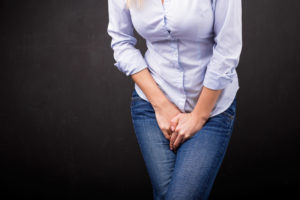Overactive bladder is a very common urinary health condition.
What is Overactive bladder?
Over 30 million Americans, both men and women, are affected by overactive bladder symptoms (OAB). Essentially, overactive bladder occurs when the detrusor muscles in the bladder contract spastically and frequently, rather than being relaxed as they should be. This condition is not normal at any age, but fortunately, is most often treatable.
OAB improvement can start with simple behavioral and lifestyle changes. Removing known bladder irritants can help slow down the constant need to urinate. Known bladder irritants include: alcohol, caffeine, carbonated beverages, smoking, spicy foods, sugars and sugar substitutes.
Overactive bladder symptoms
- Frequency – an urge to urinate more than eight times a day.
- Urgency – sudden and strong urge to urinate.
- Wetting accidents (incontinence) – an involuntary loss of urine.
- Nocturia – waking up to urinate two or more times a night.
Risk factors for OAB
While there are several reasons OAB may be occurring, there are some medical conditions associated with this condition. Note: if you have overactive bladder, it does not mean that you have these conditions.
- Diabetes
- Obesity
- Stroke
- Parkinson’s Disease
- Multiple Sclerosis
Do I have an overactive bladder?
Answer these questions with a YES or No answer:
- Do you get up more than two times a night to use the bathroom?
- Do you have an uncontrollable urge to urinate?
- Do you use the bathroom frequently throughout the day?
- Do you limit your fluid intake when you are away from home so that you don’t have to locate a bathroom?
- Do you limit your fluid intake before going to bed attempting to minimize trips to the bathroom overnight?
- When visiting a new place, do you make sure you know where the bathroom is?
- Do you avoid places that do not have a bathroom nearby (example, hiking trails)?
- Do you go to the bathroom so often that it interferes with your activities?
- Do you use pads to protect your clothes from leakage or wetting accidents?
If you answered YES to one or more of these questions, you may have overactive bladder.
How is OAB diagnosed?
- A health history and physical exam.
- Urinalysis – urine sample.
- Post void residual measurement – a test performed to see if urine remains after you have attempted to fully empty your bladder.
- Ultrasound to determine the size and shape of the kidneys, bladder and prostate (for men).
- Cystoscopy – allows the doctor to look inside the bladder.
- Urodynamic testing.
- Voiding diary.
OAB treatment
If you are diagnosed with OAB your provider will make recommendations about how to best manage your condition. A number of treatment choices are available including:
- Bladder retraining, behavior modification, lifestyle changes
- Medications prescribed to decrease the frequency and intensity of bladder contractions and to relax the smooth muscles of the bladder
- Botox – injected into the bladder
- Sacral nerve stimulation or InterStim therapy
- PTNS or Percutaneous Tibial Nerve Stimulation
- Pelvic floor physical therapy
If you are struggling with any of these symptoms, and feel that you might have overactive bladder, contact Urology Austin to schedule an appointment with one of our urologists. With treatment, quality of life issues can be greatly improved.
Dr. Rachel Sosland, Board Certified Urologist at Urology Austin, is interviewed by KXAN TV about common urological conditions that effect millions of Americans. Dr. Sosland discusses the symptoms and treatment options for urinary incontinence (stress incontinence), overactive bladder and urinary retention. She also talks about third-line therapies such as botox injections, InterStim Sacral Nerve Stimulation, and Percutaneous Tibial Nerve Stimulation (PTNS).
Bladder Control Webinar
Dr. Rachel Sosland, Urologist with Urology Austin, presents a webinar titled “Live Without Limits – Understanding Treatments for Bladder Control”. This webinar covers the diagnosis and treatment options for overactive bladder, stress incontinence and urinary retention. This webinar was co-hosted by Medtronic on May 10, 2022.
Visit the Video Page on our website to watch videos on bladder health.
Courtesy of the National Association for Continence
Living with Overactive Bladder – The OAB Care Continuum
Courtesy of the National Association for Continence
Living With OAB – Managing Through Behavior Modification
Video courtesy of the National Association for Continence
Medications for Overactive Bladder
Video courtesy of the National Association for Continence
Advanced Therapies for Overactive Bladder
Video courtesy of the National Association for Continence
Surgical Options for Overactive Bladder

